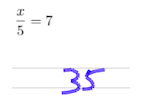Teaching equations
Tuesday, 15 September 2009 | 5 Comments
Year 8 were recently assessed on solving equations and I was a little perplexed by the results.
For one-step equations like,
![]() or
or ![]()
54% of students in one of my classes got both questions right. But even many of those showed a solution like this:

rather than something a little more formal like:

I can understand, these are simple questions with obvious solutions.
Question 2 were two step equations like these:
![]() or
or ![]()
This is where I noticed things going wrong. These questions are a little beyond intuition – 27% of the students got both correct. The wrong answers tended to show an intuitive approach or a guess and check approach using a calculator.
My conclusion from looking at this task – when it comes to assessment, many of these students reverted to prior knowledge gained in primary school rather than a more formal process they’ve seen this year.
This can be clearly seen when only 4% of students correctly solved:
![]()
I teach equations by jumping into the formal solution in the first lesson. Having said that, I “jump in” pretty gently with a fairly simple idea… keeping a seesaw balanced:
Solving Equations from Simon Job on Vimeo.
From here, I’ll start with one-step equations, and over subsequent lessons build up the complexity of the equations we’re solving.
I have looked at some of the explanatory methods like “backtracking”, but found that my students struggled with those even more. (For further discussion of three methods: 1. Guess, Check and Improve, 2. Backtracking and 3. Balancing, have a look at this PowerPoint file titled Reviewing the Models for Solving Equations found on the MANSW site.)
Dan Greene at The Exponential Curve is also discussing this issue in his post: Algebra 1: Solving Equations.
What’s my solution? I don’t really have one at the moment… have you seen the same issue of students reverting to prior knowledge, even though it’s no longer adequate? What am I doing wrong here?
Posted in • Lesson Idea • Algebra • Equations • Media • Video • Reflection | Short URL: http://mths.co/1629
Post a comment
Commenting is not available in this channel entry.New Subscribe to the …
MathsLinksemail newsletter
Get updates…
About
Simon Job — eleventh year of teaching maths in a public high school in Western Sydney, Australia.
MathsClass is about teaching and learning in a maths classroom. more→
Archive
Elsewhere
 @simonjob
@simonjob
updates via  @mathslinks
@mathslinks
Recently read/found.
Being a Vector is not Mutually Exclusive – Ringo Mok
maths vectorsInstagram
Gcf howie_hua maths
Comments
author